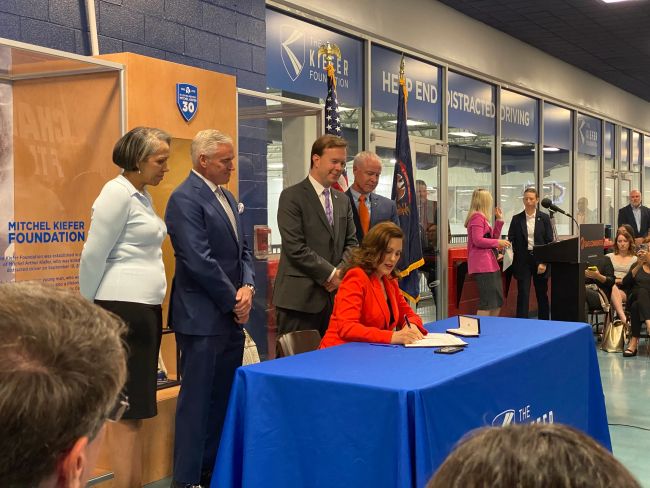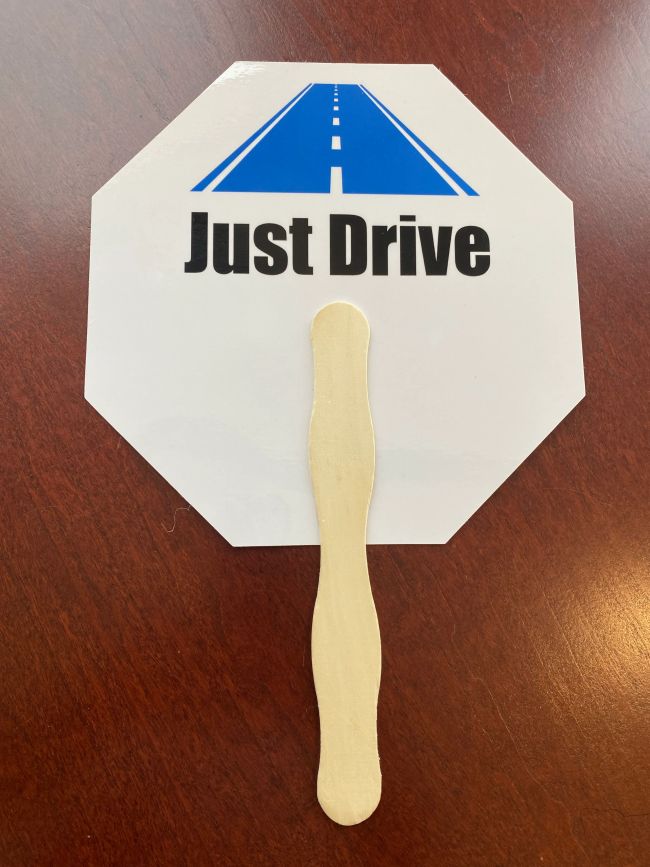On June 7th, Michigan Governor Gretchen Whitmer signed distracted driving legislation, making Michigan the 26th state to adopt some form of distracted driving/hands-free driving legislation. The signing ceremony was held at the Mitchel Kiefer Memorial Rink in USA Hockey Arena, named for the Michigan State student killed in 2016 by a distracted driver on I-96. The Mitchel Kiefer Foundation was instrumental in advocating for the passage of the bills and is working with similar groups in other states to push for the passage of distracted driving legislation across the country.
 /p>
/p>
Under prior Michigan law, it was illegal to read, type, or send a text message while operating a moving motor vehicle. The new legislation (codified at Michigan Public Acts 39, 40, and 41 of 2023), which become effective on June 30th, makes it illegal to hold a mobile electronic device while operating a motor vehicle—whether the vehicle is moving or stopped. The legislation includes certain exceptions for emergencies. While still posing enforcement challenges, the reformulated law should be easier to enforce than the "texting" legislation which did not have the deterrent effect that many hoped for when adopted in 2010.
Violations of the new distracted driving legislation generally will result in the following penalties: for an individual's first violation, a $100 civil fine or 16 hours of community service, or both; for an individual's second or subsequent violation, a $250 civil fine or 24 hours of community service, or both. If a person is involved in an accident for which they are at fault while violating this law, fines, and community service hours are doubled. Additionally, if an individual violates the law more than three times within a three-year period, he or she will be compelled to complete a basic driver improvement course. Significantly, these fines are civil and not criminal in nature and were enacted to allay concerns of some groups like the American Civil Liberties Union that the legislation would be disproportionately enforced in cities and communities of color. Section 602b(9) of P. A. 41 specifically provides: "A police officer shall not search a motor vehicle or the driver or passenger in the motor vehicle solely because of a violation of this section."
An intense communications effort will take place between now and the 4th of July holiday weekend to educate Michigan drivers on the new requirements. A heavy enforcement profile is anticipated for that weekend when many Michigan drivers travel "up north." Backers of the legislation stressed that compliance begins with each driver, and the education campaign uses a "Just Drive" mantra on placards to remind drivers of their obligations to themselves and others on the road to ensure the safe operation of motor vehicles. These handheld reminders are a safer alternative to other potential forms of communication by frustrated, compliant drivers when they see distracted driving offenders.

According to the latest data from the National Highway Traffic Safety Administration (NHTSA), 3,522 people in the United States were killed and an additional 362,415 people were injured in motor vehicle crashes involving distracted drivers in 2021. These numbers accounted for 8% of fatal crashes and 14% of injury crashes in the country.1 In that same year in Michigan, there were 59 fatalities and 16,543 total motor vehicle crashes involving distracted driving. These accidents accounted for 5.9% of all crashes in Michigan during that period.2 Notably, NHTSA has reported that accidents involving distracted driving increased by 12% between 2020 and 2021 alone.3
The Michigan legislation was supported by MichAuto, a statewide organization run by the Detroit Regional Chamber of Commerce, whose activities include education and advocacy on key issues impacting the automotive/mobility industries in Michigan, including safety. Lisa Lunsford, the CEO of automotive supplier GS3 Global and Chairperson of MichAuto, spoke on the importance of the legislation at the signing ceremony. MichAuto had been advocating for adoption for several years, supporting the heroic efforts of the Kiefer Foundation in pushing for adoption. The bill's legislative sponsors were Matt Koleszar, Christine Morse, Regina Weiss, Carrie Rheingans, Helena Scott, Brenda Carter, Samantha Steckloff, Felicia Brabec, Karen Whitsett, Tyrone Carter, and Mike Mueller. Governor Whitmer had voiced her support for the legislation going as far back as her first State of the State address in early 2019.
In 2020, distracted drivers killed 3,142 people nationwide. That tragic number climbed to a staggering 3,522 deaths in 2021.4 Recognizing that state legislatures regulate the operation of vehicles on its roads and the role states can serve in promoting vehicle safety, in 2020 the National Highway Traffic Safety Administration (NHTSA) announced the availability of $297 million in grant funding for its State and Community Highway Safety Program.5 NHTSA distributes these funds through grants to the states to promote and facilitate state enforcement of distracted driving regulations. Under the Fixing America's Surface Transportation (FAST) Act of 2015, NHTSA conditions issuing these grants on states enacting distracted driving laws, similar to the Michigan law. These distracted-driving grants support similar programs geared to promoting road safety such as drunk driving, motorcycle helmets, and child seats programs.
For manufacturers, NHTSA has issued guidelines that encourage developers to consider when creating and integrating applications for in-vehicle electronic devices and portable aftermarket devices. The guidelines seek to "promote safety by discouraging the introduction of excessively distracting devices in vehicles" and to "provide a safety framework for developers."6 Though nonbinding and voluntary, the guidelines are intended to limit and reduce potential distractions for drivers using electronic devices in vehicles.
Automakers must do their part in supporting distracted driver legislation and minimizing driver distraction, which poses challenges as more and more technology is incorporated into the cockpit of vehicles. Recent decisions by certain OEMs not to include features like Apple CarPlay® may undercut this effort, which enables more seamless "hands-free" driving. Larger economic forces are at play here, including the desire of OEMs to control data associated with the operation of their vehicles. A proper balance needs to be struck to address both of these imperatives.
Foley will continue to monitor developments in Automotive Safety and will keep readers informed about any major developments that come down the line. For the most up-to-date material, follow our blog, Dashboard Insights.
Special thanks to Emma C. Flanigan, a 2023 summer associate, for her contributions to this article.
Footnotes
1. https://crashstats.nhtsa.dot.gov/Api/Public/ViewPublication/813443#
4. https://www.nhtsa.gov/risky-driving/distracted-driving#resources
5. https://www.nhtsa.gov/press-releases/nhtsa-announces-release-562-million-highway-safety-grants
6. Visual-Manual NHTSA Driver Distraction Guidelines for In-Vehicle Electronic Devices, 78 FR 24817, 24818 (Apr. 26, 2013); Visual-Manual NHTSA Driver Distraction Guidelines for Portable and Aftermarket Devices, 81 FR 87656 (Dec. 5, 2016).
The content of this article is intended to provide a general guide to the subject matter. Specialist advice should be sought about your specific circumstances.




